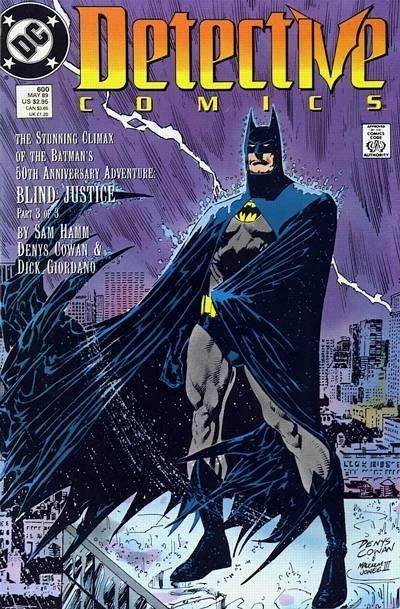Each day in November, I will read and review/discuss/whatever one comic taken from a box of some of my childhood comics. Today, it's Detective Comics #600.
The Nostalgia November archive can be found here.
Detective Comics #600 by Sam Hamm, Denys Cowan, and Dick Giordana is both a celebration of the 50th anniversary of Batman and the concluding part of the "Blind Justice" storyarc wherein Bruce Wayne has been framed as a traitor and is now in a coma after being shot. This is a rather good comic, actually. 60 pages of story plus some pin-ups and short thoughts by various people on Batman... a solid anniversary package all around. Sam Hamm wrote the screenplay for Batman, so bringing him in to write the comic with his story concluding with the big anniversary issue in 1989 seemed like a smart move. And, it works well since the story here isn't half bad. It gets a little convoluted with various plots involving micro-chips implanted in people that allows others to take over their brains and, honestly, the Bruce Wayne as traitor plot goes nowhere, but, otherwise, there are a few really great moments in this comic.
The first big thing that Hamm adds to the story is Henri Ducard, an amoral brilliant man that helped train Bruce Wayne on his path to become Batman. He basically works for the highest bidder and is in Gotham to make sure Wayne goes to prison, hired by those that framed him. While in Gotham, he figures out that Wayne is Batman and offers to testify for Wayne instead of against him... for the right price. He gives a rathe scathing review of Batman that I absolutely love:
TRUE EVIL SELDOM ANNOUNCES ITSELF SO LOUDLY. THE DANGEROUS ONES SET THEIR SUBVERSIVE GOALS, AND ACHIEVE THEM, BIT BY BIT... INVISIBLY, INEVITABLY. THEY HAVE NO TASTE FOR THEATER. WHILE BATMAN BUSIES HIMSELF WITH PETTY THIEVES AND GAUDY MADMEN, AN ABYSS OF ROT YAWNS EVEN WIDER AT HIS FEET. HE'S A BAND-AID ON A CANCER PATIENT. I AM OF COURSE NO MORALIST, BUT THIS BATMAN, I THINK, HAS A VERY POOR UNDERSTANDING OF THE WORLD.
In the end, Ducard does a different job in Gotham, leaves Bruce a note, and leaves. He's appeared once or twice since, but really comes off as a great character. Amoral but insightful -- someone who doesn't really care about Batman, because Batman is too small. The character was used again in Batman Begins with Liam Neeson playing him in an altered version.
The other big element to this plot is how Bruce Wayne overcomes his disability. He wakes up from the coma, but the bullet left him paralysed. Using the mind-infiltrating technology, he actually pilots another person's body to continue acting as Batman. In this case, it's Roy Kane, an athletic guy that Bruce helped reuinite with his sister Jennie and they've been living at his mansion (possibly -- it's unclear). Roy stumbles across the Batcave and volunteers to let Bruce pilot him. The initial outting is kind of fun as Bruce struggles to keep going with a body that, by most standards, is in shape, but isn't in the shape that's required to be Batman. Ultimately, this use of Roy leads to a showdown against the main villain, Kenneth Harbinger, the man who invented the technology to allow putting one person's mind inside another's body -- he's also the man who shot Bruce and has been switching bodies ever since. The fight at the end results in both Harbinger and Roy's deaths. That's an important event that's gone largely unnoticed since: Batman caused the death of Roy Kane. I haven't seen this event referenced ever, which is odd.
The death of Batman (since Roy was in costume) raises various questions. It culiminates in a scene where Commissioner Gordon visiting Bruce Wayne (ostensibly because Roy was living at Wayne Manor) and it becomes very clear that Gordon has figured out not just that Bruce is Batman, but how Roy came to be in the costume. He even lets Bruce off the hook a bit. Another important/big scene.
There is the question raised about Batman not being around, but that strikes me as odd since it wouldn't be uncommon for Batman to be outside of Gotham with the various cases that lead him to other places or his work with other heroes. Funny how those things are ignored by everyone when there's actually an in-story reason why Batman isn't around that's problematic for him...
Denys Cowan's art is great. Rough, angular, dark... it suits Hamm's script well. He's very good at giving each character their own look: facial expressions, body language, and such... and then playing those elements up. There's a scene where Alfred and Roy test out the mind-technology and Cowan adapts well, drawing Roy with Alfred's body language and facial expressions... very well done.
The bonus stuff is good, too. Some Batman pics by the likes of Neal Adams, Walter Simonson, Will Eisner, and others, while various notables like Stephen King, Penn and Teller, Adam West, and other mostly non-comic people share their thoughts on Batman. Kind of cool.
All in all, exactly what you'd except for a big 50th anniversary issue. I just wish the story had a more lasting impact, like it should have.


